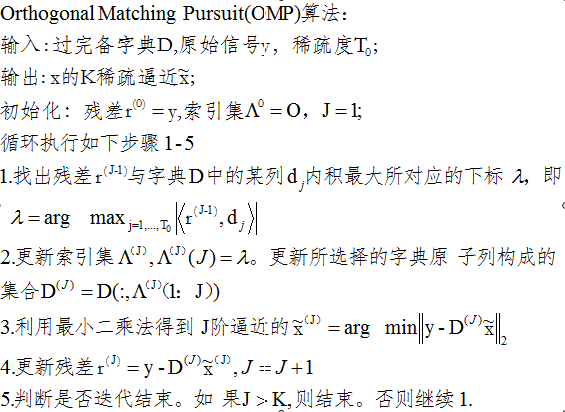最近学习K-SVD算法的过程中,稀疏编码部分使用了OMP追踪算法,特作此总结。
求解问题:

其中D是过完备的字典,已经给定,Y是原始信号,X待求。
OMP算法的本质思想是:以贪婪迭代的方法选择D的列,使得在每次迭代的过程中所选择的列与当前冗余向量最大程度的相关,从原始信号向量中减去相关部分并反复迭代,只到迭代次数达到稀疏度K,停止迭代。
核心算法步骤如下:

相关Matlab代码如下:
function [A]=OMP(D,X,L);
%=============================================
% Sparse coding of a group of signals based on a given
% dictionary and specified number of atoms to use.
% ||X-DA||
% input arguments:
% D - the dictionary (its columns MUST be normalized).
% X - the signals to represent
% L - the max. number of coefficients for each signal.
% output arguments:
% A - sparse coefficient matrix.
%=============================================
[n,P]=size(X);
[n,K]=size(D);
for k=1:1:P,
a=[];
x=X(:,k); %the kth signal sample
residual=x; %initial the residual vector
indx=zeros(L,1); %initial the index vector
%the jth iter
for j=1:1:L,
%compute the inner product
proj=D'*residual;
%find the max value and its index
[maxVal,pos]=max(abs(proj));
%store the index
pos=pos(1);
indx(j)=pos;
%solve the Least squares problem.
a=pinv(D(:,indx(1:j)))*x;
%compute the residual in the new dictionary
residual=x-D(:,indx(1:j))*a;
%the precision is fill our demand.
% if sum(residual.^2) < 1e-6
% break;
% end
end;
temp=zeros(K,1);
temp(indx(1:j))=a;
A(:,k)=sparse(temp);
end;
return;
http://blog.sciencenet.cn/blog-810210-653094.html
最后
以上就是个性汽车最近收集整理的关于Orthogonal Matching Pursuit(OMP)正交匹配追踪算法的全部内容,更多相关Orthogonal内容请搜索靠谱客的其他文章。
本图文内容来源于网友提供,作为学习参考使用,或来自网络收集整理,版权属于原作者所有。








发表评论 取消回复